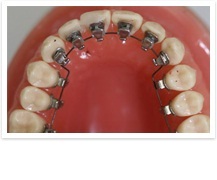
The term "lingual braces" refers to a method of orthodontic treatment where the brackets and wires that produce the patient's tooth realignment are attached to the backside (palate or tongue side) of their teeth, as opposed to the front or cheek side as is the case with traditional dental braces. While the positioning of the patient's orthodontic hardware is just the opposite as that found with traditional dental braces, both techniques and the materials they employ are otherwise very similar. The chief advantage of lingual braces lies in the fact that they are non-visible. By "non-visible," as opposed to the term "invisible," we mean that if someone carefully looks they may catch a glimpse of your lingual braces but otherwise they are not easily detected.
Pros: Invisible from outside
Cons: Difficult to clean; more expensive; not appropriate for severe cases; can be more uncomfortable at first; regular adjustments take longer and are more difficult than with traditional brace



 How to Reach Us
How to Reach Us  Photo Gallery
Photo Gallery